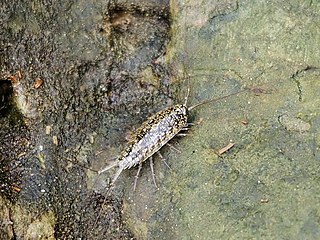
Charybdis is a genus of swimming crabs in the family Portunidae. It is named after the monster Charybdis of Greek mythology.

Sphaeromatidae is a family of isopods, often encountered on rocky shores and in shelf waters in temperate zones. The family includes almost 100 genera and 619 known marine species. Within these genera, there are groups that share distinctive morphologies; further research may reclassify these genus-groups as separate families.
Amphoroidea is a genus of isopod of the family Sphaeromatidae, containing the following species:

The Cymothoidae are a family of isopods in the suborder Cymothoida found in both marine and freshwater environments. Cymoithoids are ectoparasites, usually of fish, and they include the bizarre "tongue-biter", which attaches to a fish's tongue, causing it to atrophy, and replaces the tongue with its own body. Ceratothoa oestroides is one of the most devastating ectoparasites in Mediterranean aquaculture. Around 40 genera and more than 380 species of cymothoid are recognised. Species of the Cymothoidae are generally found in warmer waters and rarely in the cool and cold climates.
Serolis is a genus of isopod crustacean, containing the following species:

Archaeoniscus is a genus of prehistoric isopods that first appeared during the Bajocian stage of the Middle Jurassic. It is a widespread genus with a paleogeographic distribution encompassing the continental margin environments of the central Atlantic Ocean and the western Tethys Ocean. Fossils of Archaeoniscus suggest that this genus lived in diverse aquatic habitats, including the marine, paralic, and freshwater environments. While earlier descriptions suggested that it may have had an ectoparasitic association with fishes, some researchers argue that at least two species, A. aranguthyorum and A. coreaensis, lived a benthic free-living lifestyle based on morphological characteristics that are either unsuitable for or unrelated to parasitic behavior.

The Idoteidae are a family of isopod crustaceans. It includes these genera:
Edward John Miers FZS FLS was a British zoologist and curator of the crustacean collection at the Natural History Museum in London. He contributed to the scientific reports from the Challenger expedition of 1872–1876, and described 32 new genera and at least 260 new species and subspecies of decapod crustaceans, along with four genera and 72 new species in other orders.

Cymothoida is the name of a suborder of isopod crustaceans with a mostly carnivorous or parasitic lifestyle. It contains more than 2,700 described species in four superfamilies. Members of the suborder are characterised by their specialised mouthparts which include a mandible with a tooth-like process which is adapted for cutting or slicing.

Gnorimosphaeroma is a genus of isopod crustaceans, containing the following species:

Cymothoa is a genus of parasitic isopod crustaceans, containing the species listed below. Not all Cymothoa species are considered parasitic. Some climb onto fish in an act known as phoresy.

Idotea balthica is a species of marine isopod which lives on seaweed and seagrass in the subtidal zone of rocky shores and sandy lagoons.

Ebalia is a genus of crab in the family Leucosiidae.

Ligia baudiniana is a woodlouse in the family Ligiidae. It has a coarsely granular surface and large eyes that are very close together.

Aega is a genus of isopods in the family Aegidae, containing the following species:

Nerocila is a genus of parasitic isopod crustaceans, with 11 species, which have been found parasitizing Indian marine fishes.

Ceratothoais a genus of isopod ectoparasites of teleost fish, first described by James Dwight Dana in 1852. Infection by Ceratothoa can cause anaemia, lesions, growth retardation, emaciation, and mortality in their fish hosts.
Euidotea is a genus of marine isopods belonging to the family Idoteidae. The species of this genus are found in Australia and New Zealand.













